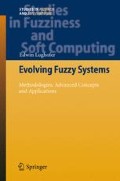Abstract
The first section in this chapter deals with a summary of various application fields, where evolving fuzzy systems approaches have been successfully applied and installed, covering evolving inferential sensors, tracking of objects in video streams, adaptive knowledge-discovery in bio-informatics and dynamic forecasting tasks in financial markets. The second part of this chapter (Sections 10.2.1 to 10.2.3) is dedicated to application fields, where evolving fuzzy systems and classifiers have not been applied so far (to the best of our knowledge, status: 30th of June 2010), but may serve as potential components in the near future in order to enhance adaptability, flexibility, degree of automatization and also the level of human-machine interaction in industrial systems. These enhancements can be seen as basic building blocks for a better productivity and higher process safety and user-friendliness of these systems during on-line operation mode. The potential fields of application for evolving fuzzy systems handled in this chapter are the following:
-
Adaptive open-loop control (Section 10.2.1): evolving fuzzy systems are applied for automatic generation of non-linear controllers from data, which can be further updated during on-line control mode to permanently improve the control rules/strategies, e.g. adapting to new control system states.
-
Chemometric modelling (Section 10.2.2): deals with quantification of the composition of chemical substances in materials; here, it is a big challenge to automatize the quantification process by (non-linear) models extracted from measured spectral data and updated during on-line production process.
-
Interactive machine learning (Section 10.2.3): a generic concept for enhancing interaction and increasing knowledge exchange between humans and machine learning systems; evolving fuzzy systems could play a central role in such a concept, as, when combined with the techniques for improving interpretability of EFS (Chapter 6), providing linguistic and also visual insight into the behavior and underlying dependencies of the process.
Access this chapter
Tax calculation will be finalised at checkout
Purchases are for personal use only
Preview
Unable to display preview. Download preview PDF.
Rights and permissions
Copyright information
© 2011 Springer-Verlag Berlin Heidelberg
About this chapter
Cite this chapter
Lughofer, E. (2011). Further (Potential) Application Fields. In: Evolving Fuzzy Systems – Methodologies, Advanced Concepts and Applications. Studies in Fuzziness and Soft Computing, vol 266. Springer, Berlin, Heidelberg. https://doi.org/10.1007/978-3-642-18087-3_10
Download citation
DOI: https://doi.org/10.1007/978-3-642-18087-3_10
Publisher Name: Springer, Berlin, Heidelberg
Print ISBN: 978-3-642-18086-6
Online ISBN: 978-3-642-18087-3
eBook Packages: EngineeringEngineering (R0)

